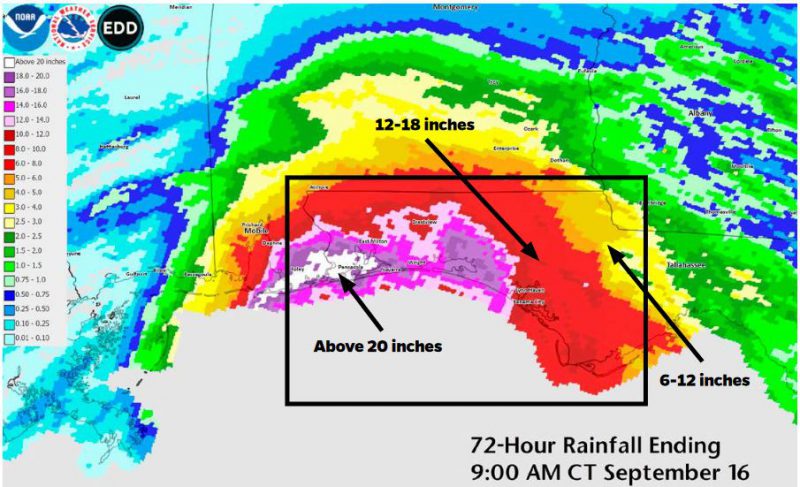Kirsten Romaguera, Public Relations Specialist, UF/IFAS Communications
The combination of crops, livestock and aquaculture products lost as a result of Hurricane Sally will likely be valued between $55 million and $100 million, University of Florida economists predict.
The estimate was released as part of a new document, “Preliminary Assessment of Agricultural Losses and Damages resulting from Hurricane Sally,” from the UF/IFAS Economic Impact Analysis Program.
“Unlike most hurricanes, where wind is the driving force behind a majority of the damages, Hurricane Sally also included a lot of rainfall in a short period of time in an area that already had saturated ground,” said Christa Court, director of the program and assistant professor in the UF/IFAS food and resource economics department. “There were still impacts like pecans blown off trees, but we also have to account for significantly more water impacting crop fields and grazing lands than we usually see.”

72-hour precipitation pattern of Tropical Storm/Hurricane Sally as of 9:00 a.m. CT September 16, 2020. Image Credit: National Weather Service.
–
The program conducts assessments after any event that disrupts the standard operations of Florida’s agriculture industry; usually, the surveys are deployed after natural disasters like hurricanes, floods and wildfires, but this year also included assessments of the impacts from the COVID-19 pandemic.
Court and her colleagues began collecting baseline data for agricultural losses and damages resulting from tropical cyclone events in 2016, in the wake of Hurricane Irma. Since then, the program has continued to improve its baseline and impact databases for these types of analyses.
Even with this comparison data available to the research team, analyzing Hurricane Sally’s impacts is still complicated, the preliminary assessment notes. Hurricane Irma’s winds had a minimal effect on the Panhandle region, with more impacts felt throughout South and Central Florida. And although Hurricane Michael’s reach overlapped some with Sally’s, the 2018 storm was more intense upon landfall and maintained its strength for a longer stretch inland, but its faster movement meant less precipitation overall.
To assist with the analysis, the UF/IFAS Economic Impact Analysis Program used data from multiple sources, in addition to its previous post-storm assessments. The National Hurricane Center’s imagery of the storm was combined with geospatial data from the Florida Department of Agriculture and Consumer Services on croplands in the area. The researchers then used information from the UF/IFAS Electronic Data Information Source and the U.S. Department of Agriculture’s National Agricultural Statistics Service (USDA-NASS) QuickStats database to adjust for season and harvest times. Once the impacted agricultural products were determined, a valuation was estimated using information from USDA-NASS and an economic modeling program called IMPLAN.
The researchers also gleaned insights from Cooperative Extension personnel at Texas A&M University, who assessed Texas’ agricultural losses in the wake of Hurricane Harvey in 2017. Harvey was a similarly slow-moving storm that drenched much of the Texas Gulf Coast.
According to the National Weather Service, Hurricane Sally dropped up to 20 inches of rainfall in a 72-hour timeframe, with the highest levels inundating the coastline along the Alabama/Florida border. Precipitation topped 12 inches as far away as Franklin County, a coastal county within an hour’s drive of Tallahassee.
Despite heavy flooding prohibiting full assessments of some fields, the researchers were able to collect some visual assessments that indicate what those larger impacts may be. Among their predictions:
- Field and row crops will likely experience significant losses due to wind damage and heavy precipitation and flooding. In the affected area, this includes crops like peanuts, cotton, soybeans and hay, to name a few.
- Shellfish harvest closures are expected to cause losses for aquaculture producers.
- Livestock operations (beef and dairy cattle, horses, poultry, etc.) and producers of animal products (milk, eggs, honey) may suffer losses due to damaged fencing and loss of electricity.
- Unsold, already-harvested crops in inadequate storage are likely to be losses attributed to direct storm causes or indirect future damages, like rot.
“We anticipate that as fields dry out and can be effectively assessed, we will capture a more complete picture of the losses to the agricultural producers in this region,” Court said. “We’re going to continue to gather assessments for Hurricane Sally damage and losses for at least the next several weeks, but our preliminary valuation estimate is a range to account for many of these unknowns. What isn’t destroyed may have diminished yield or quality, and then there’s secondary factors like disease spread due to missed control methods, or damage to equipment and infrastructure.”
- Crop Disaster Assistance for 2025: Is it Coming or Not? - November 21, 2025
- Cotton Marketing News:Much Anticipated November Numbers Include Larger Production and Very Slight Demand Increase - November 21, 2025
- Pierce’s Disease-Resistant Wine Grape Breakthrough Offers Hope for a Florida Wine Renaissance - November 14, 2025

